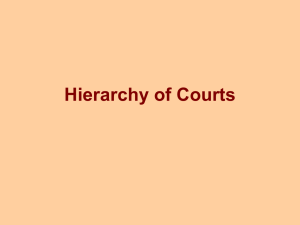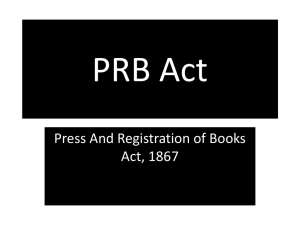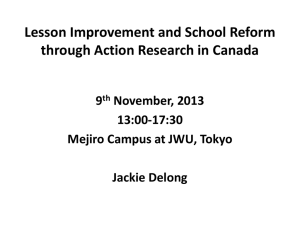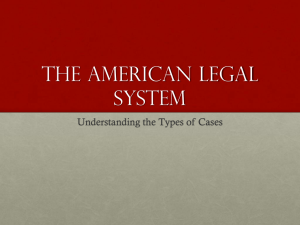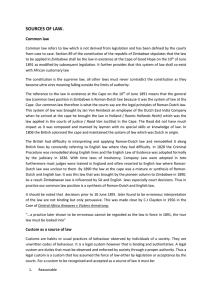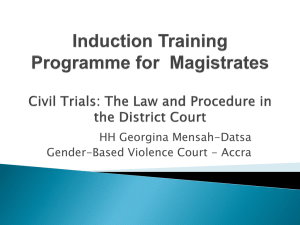Justice Mirza Hussain Haider - Asian Judges Network on
advertisement
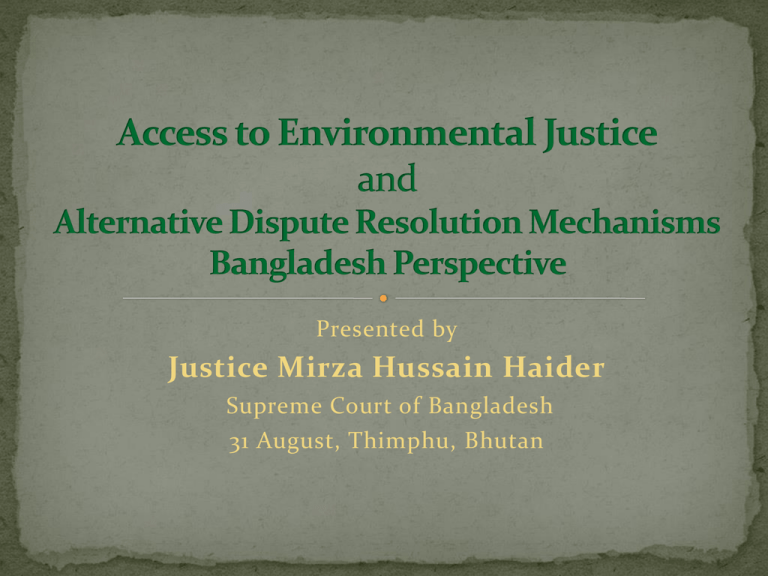
Presented by Justice Mirza Hussain Haider Supreme Court of Bangladesh 31 August, Thimphu, Bhutan The Constitution of the People’s Republic of Bangladesh, 1972 * Article 102 – Power of High Court Division to issue certain orders and directions, etc. * Article 18A – Protection and improvement of environment and biodiversity * Article 31 – Right to protection of law * Article 32 – Protection of right to life and personal liberty * Article 40 – Freedom of profession or occupation The Penal Code, 1860 * Section 268 – provides punishment for the offence of committing a public nuisance * Sections 269 & 270 – a negligent act resulting in an infection that is dangerous to life is an offence * Sections 272 to 276 – acts of adulteration of food, drinks and drugs are offences * Section 277 – contaminating the water of a public spring or reservoir to make it unfit for ordinary use is a punishable offence * Section 278 – poisoning the atmosphere to the detriment of persons living in the neighborhood or passing along a public way is a punishable offence * Sections 284 to 287 – negligence in the use of poisonous substance, fire and combustible matter, explosive substances and machinery is also punishable if it results in danger to human life The Code of Civil Procedure, 1908 * Section 9 – empowers the court to try suits of civil nature – relief in the form of damages, injunction, interim orders, declaration and decree * Section 91 – suit may be filed in case of a public nuisance or other wrongful acts affecting or likely to affect the public * Order 1 Rule 8 – class action The Code of Criminal Procedure, 1898 * Section 133 – an executive magistrate can interfere and remove a pubic nuisance of an environmental nature * Section 142 – he can adopt immediate measures to prevent danger or injury of a serious kind to the public * Section 144 – for prevention of danger to human life, health or safety, the magistrate can direct a person to abstain from certain acts The Environment Conservation Act, 1995 * Section 4(3) – Power of the DG, DoE to issue direction for the closure, prohibition or regulation of any industry, initiative or process * Section 8(2) – Power of the DG to adopt any measures including public hearings for settling an application regarding environmental pollution or degradation * Section 14 – Any person aggrieved may prefer an appeal to the appellate authority and the order passed by such authority on appeal shall be final and no suit can be filed in any court against such order *Section 4, 6, 6A, 9, 12 – Offences - Non-compliance with directions, harmful activities in ECAs; emitting injurious smoke from vehicles; manufacture, sale of injurious articles; discharge of excessive environmental pollutants; operating industry/project without environmental clearance The Environment Court Act, 2010 * Section 4 – Establishment of Environment Courts in each district to try offences under the ECA and any other law specified by the government for the purposes of this law * Section 5 – Establishment of Special Magistrate Courts * Section 6 – Jurisdiction of Special Magistrate Court * Section 7 – Jurisdiction of Environment Court * Section 20- Environment Appellate Court Sub-ordinate Civil Courts Jurisdiction District Judge Admits, hears and disposes: (1) Civil Appeals from subordinate courts (2)Civil Revision Additional District Judge Hears and disposes cases as transferred to it by District Judge Joint District Judge Admits, hears and disposes Civil Suits of original jurisdiction valued more than Tk.4,00,000.00 Senior Assistant Judge Admits, hears and disposes civil suits of original jurisdiction of valued in between Tk. 2,00,000.00 to 4,00,000.00 Assistant Judge Admits, hears and disposes civil suits of original jurisdiction valued upto Tk.2,00,000.00 Sub-ordinate Criminal Courts Jurisdiction Sessions Judge Hears, on transfer from Magistracy, criminal Cases having sentence of Death and Imprisonment more than 10 years. Additional Sessions Judge Alike the Sessions Judge Assistant Sessions Judge Hears criminal cases having sentence of Imprisonment upto 10 years Judicial Magistrate of 1st Class Takes cognizance of criminal cases and transfers them to appropriate sessions court. Tries offense having sentence upto 5 years Judicial Magistrate of 2nd Class Judicial Magistrate of 3rd Class Executive Magistrate Holds Mobile Court Admits& tries Section 144, Section 145, Section 107 of the Cr.PC. Nos. of courts – 3 (Dhaka, Chittagong and Sylhet) Nos. of cases filed since 2002– 1123 Nos. of cases disposed of – 424 Nos. of pending cases - 699 Issues involved – manufacture, sale, etc. of polythene; discharging of excessive environmental pollutant by industries; industries/brick kilns operating without environmental clearance; cutting of hills, vehicles emitting smoke injurious to environment; illegal and unplanned construction; noise pollution The Bangladesh Environment Conservation Act, 1995 *Section 8(2) empowers D.G. to hold public hearing and take any other measure for disposing of any application or resolving any dispute in respect of environment. The Environment Court Act, 2010 * Section 18 –Dispute Resolution – this provision is subject to prior approval and satisfaction of the DG, DoE - include a condition of depositing of TK 50,000 to the office of DG, DoE and compliance of the order of the DG or his empowered agent before availing this opportunity Legal and Judicial Political, Social and Economic- environment still a footnote * inequity and poverty-parties not on equal footing * mass representation, lack of organization at the community level (PIL) * administrative relief – bias, partial * lack of sub-ordinate rules (mode of public hearing, consultation not defined) * unclear/limited/overlapping jurisdiction of the environment court * lack of access to information/dispute over facts –(committee, experts, calling of records) * restrictive interpretation of the legal provision * scientific and technical expertise/ understanding * enforcement (continuing mandamus)
